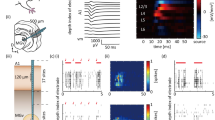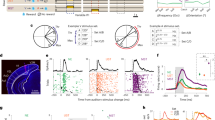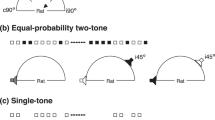Abstract
Studies of cortical connections or neuronal function in different cerebral areas support the hypothesis that parallel cortical processing streams, similar to those identified in visual cortex, may exist in the auditory system. However, this model has not yet been behaviorally tested. We used reversible cooling deactivation to investigate whether the individual regions in cat nonprimary auditory cortex that are responsible for processing the pattern of an acoustic stimulus or localizing a sound in space could be doubly dissociated in the same animal. We found that bilateral deactivation of the posterior auditory field resulted in deficits in a sound-localization task, whereas bilateral deactivation of the anterior auditory field resulted in deficits in a pattern-discrimination task, but not vice versa. These findings support a model of cortical organization that proposes that identifying an acoustic stimulus ('what') and its spatial location ('where') are processed in separate streams in auditory cortex.
This is a preview of subscription content, access via your institution
Access options
Subscribe to this journal
Receive 12 print issues and online access
$209.00 per year
only $17.42 per issue
Buy this article
- Purchase on Springer Link
- Instant access to full article PDF
Prices may be subject to local taxes which are calculated during checkout







Similar content being viewed by others
References
Ungerleider, L.G. & Mishkin, M. Two cortical visual systems. in Analysis of Visual Behavior (eds. Ingle, D.J., Goodale, M.A. & Mansfield, R.J.W.) 486–549 (MIT Press, Cambridge, Massachusetts, 1982).
Mishkin, M., Ungerleider, L.G. & Macko, K.A. Object vision and spatial vision: two cortical pathways. Trends Neurosci. 6, 414–417 (1983).
Ungerleider, L.G. & Haxby, J.V. “What” and “where” in the human brain. Curr. Opin. Neurobiol. 4, 157–165 (1994).
Courtney, S.M., Ungerleider, L.G., Keil, K. & Haxby, J.V. Object and spatial visual working memory activate separate neural systems in human cortex. Cereb. Cortex 6, 39–49 (1996).
Morel, A. & Bullier, J. Anatomical segregation of two cortical visual pathways in the macaque monkey. Vis. Neurosci. 4, 555–578 (1990).
Bullier, J., Girard, P. & Salin, P.A. The role of area 17 in the transfer of information to exstriate visual cortex. in Cerebral Cortex 10 (eds. Peters, A. & Rockland, K.S.) 301–330 (New York, Plenum Press, 1994).
Lomber, S.G., Payne, B.R., Cornwell, P. & Long, K.D. Perceptual and cognitive visual functions of parietal and temporal cortices of the cat. Cereb. Cortex 6, 673–695 (1996).
Goodale, M.A. & Milner, A.D. Separate visual pathways for perception and action. Trends Neurosci. 15, 20–25 (1992).
Rauschecker, J.P. Processing of complex sounds in the auditory cortex of cat, monkey and man. Acta Otolaryngol. Suppl. 532, 34–38 (1997).
Rauschecker, J.P., Tian, B., Pons, T. & Mishkin, M. Serial and parallel processing in rhesus monkey auditory cortex. J. Comp. Neurol. 382, 89–103 (1997).
Rauschecker, J.P. Parallel processing in the auditory cortex of primates. Audiol. Neurootol. 3, 86–103 (1998).
Rauschecker, J.P. Cortical processing of complex sounds. Curr. Opin. Neurobiol. 8, 516–521 (1998).
Tian, B., Reser, D., Durham, A., Kustov, A. & Rauschecker, J.P. Functional specialization in rhesus monkey auditory cortex. Science 292, 290–293 (2001).
Romanski, L.M. et al. Dual streams of auditory afferents target multiple domains in the primate prefrontal cortex. Nat. Neurosci. 2, 1131–1136 (1999).
Clarke, S. et al. What and where in human audition: selective deficits following focal hemispheric lesions. Exp. Brain Res. 147, 8–15 (2002).
De Santis, L., Clarke, S. & Murray, M.M. Automatic and intrinsic auditory “what” and “where” processing in humans revealed by electrical neuroimaging. Cereb. Cortex 17, 9–17 (2007).
Kelly, J.B. & Whitfield, I.C. Effects of auditory cortical lesions on discriminations of rising and falling frequency-modulated tones. J. Neurophysiol. 34, 802–816 (1971).
Neff, W.D., Diamond, I.T. & Casseday, J.H. Behavioral studies of auditory discrimination: central nervous system. in Handbook of Sensory Physiology. Auditory system Vol. V/2 (eds Keidel, W.D., & Neff, W.D.) 307–400 (New York, Springer-Verlag, 1975).
Morel, A. & Imig, T.J. Thalamic projections to fields A, AI, P and VP in the cat auditory cortex. J. Comp. Neurol. 265, 119–144 (1987).
Lee, C.C. & Winer, J.A. Connections of cat auditory cortex. I. Thalamococortical system. J. Comp. Neurol. 507, 1879–1900 (2008).
Stecker, G.C., Mickey, B.J., Macpherson, E.A. & Middlebrooks, J.C. Spatial sensitivity in field PAF of cat auditory cortex. J. Neurophysiol. 89, 2889–2903 (2003).
Lomber, S.G., Payne, B.R. & Horel, J.A. The cryoloop: an adaptable reversible cooling deactivation method for behavioral and electrophysiological assessment of neural function. J. Neurosci. Methods 86, 179–194 (1999).
Heffner, H.E. & Heffner, R.S. Reply to “The sound-localization ability of cats”. J. Neurophysiol. 94, 3653–3655 (2005).
Malhotra, S., Hall, A.J. & Lomber, S.G. Cortical control of sound localization in the cat: unilateral cooling deactivation of 19 cerebral areas. J. Neurophysiol. 92, 1625–1643 (2004).
Yang, X.-F., Kennedy, B.R., Lomber, S.G., Schmidt, R.E. & Rothman, S.M. Cooling produces minimal neuropathology in neocortex and hippocampus. Neurobiol. Dis. 23, 637–643 (2006).
Knight, P.L. Representation of the cochlea within the anterior auditory field (AAF) of the cat. Brain Res. 130, 447–467 (1977).
Reale, R.A. & Imig, T.J. Tonotopic maps of auditory cortex in the cat. J. Comp. Neurol. 192, 265–292 (1980).
Teuber, H.-L. Physiological psychology. Annu. Rev. Psychol. 6, 267–296 (1955).
Warrington, E.K. & Rabin, P. A preliminary investigation of the relation between visual perception and visual memory. Cortex 6, 87–96 (1970).
Petrides, M. Dissociable roles of mid-dorsolateral prefrontal and anterior inferotemporal cortex in visual working memory. J. Neurosci. 20, 7496–7503 (2000).
Winters, B.D., Forwood, S.E., Cowell, R.A., Saksida, L.M. & Bussey, T.J. Double dissociation between the effects of peri-postrhinal cortex and hippocampal lesions on tests of object recognition and spatial memory: heterogeneity of function within the temporal lobe. J. Neurosci. 24, 5901–5908 (2004).
Ahveninen, J. et al. Task-modulated “what” and “where” pathways in human auditory cortex. Proc. Natl. Acad. Sci. USA 103, 14608–14613 (2006).
MacDonald, A.W., III, Cohen, J.D., Stenger, V.A. & Carter, C.S. Dissociating the role of dorsolateral prefrontal and anterior cingulate cortex in cognitive control. Science 288, 1835–1838 (2000).
Jones, E.G. The Thalamus (Plenum Press, New York, 1985).
Phillips, D.P., Semple, M.N. & Kitzes, L.M. Factors shaping the tone level sensitivity of single neurons in posterior field of cat auditory cortex. J. Neurophysiol. 73, 674–686 (1995).
Loftus, W.C. & Sutter, M.L. Spectrotemporal organization of excitatory and inhibitory receptive fields of cat posterior auditory field neurons. J. Neurophysiol. 86, 475–491 (2001).
Tian, B. & Rauschecker, J.P. Processing of frequency-modulated sounds in the cat's anterior auditory field. J. Neurophysiol. 71, 1959–1975 (1994).
Goodale, M.A., Milner, A.D., Jakobson, L.S. & Carey, D.P. A neurological dissociation between perceiving objects and grasping them. Nature 349, 154–156 (1991).
Goodale, M.A. & Westwood, D.A. An evolving view of duplex vision: separate, but interacting, cortical pathways for perception and action. Curr. Opin. Neurobiol. 14, 203–211 (2004).
Cavina-Pratesi, C., Goodale, M.A. & Culham, J.C. fMRI reveals a dissociation between grasping and perceiving the size of real 3D objects. PLoS ONE 5, e424 (2007).
Griffiths, T.D. & Warren, J.D. What is an auditory object? Nat. Rev. Neurosci. 5, 887–892 (2004).
Kaas, J.H. & Hackett, T.A. Subdivisions of auditory cortex and processing streams in primates. Proc. Natl. Acad. Sci. USA (USA) 97, 11793–11799 (2000).
Griffiths, T.D., Buchel, C., Frackowiak, R.S. & Patterson, R.D. Analysis of temporal structure in sound by the human brain. Nat. Neurosci. 1, 422–427 (1998).
Krumbholz, K. et al. Representation of interaural temporal information from left and right auditory space in the human planum temporale and inferior parietal lobe. Cereb. Cortex 15, 317–324 (2005).
Clarke, S., Bellmann, A., Meuli, R.A., Assal, G. & Steck, A.J. Auditory agnosia and auditory spatial deficits following left hemispheric lesions: evidence for distinct processing. Neuropsychologia 38, 797–807 (2000).
Alain, C., Arnott, S.R., Hevenor, S., Graham, S. & Grady, C.L. “What” and “where” in human auditory system. Proc. Natl. Acad. Sci. USA 98, 12301–12306 (2001).
Maeder, P.P. et al. Distinct pathways involved in sound recognition and localization: a human fMRI study. Neuroimage 14, 802–816 (2001).
Arnott, S.R., Binns, M.A., Grady, C.L. & Alain, C. Assessing the auditory dual-pathway model in humans. Neuroimage 22, 401–408 (2004).
Populin, L.C. & Yin, T.C.T. Behavioral studies of sound localization in the cat. J. Neurosci. 18, 2147–2160 (1998).
Reinoso-Suárez, F. Topographical Atlas of the Cat Brain for Experimental-Physiological Research [German] (Merck, Darmstadt, Germany, 1961).
Acknowledgements
We thank A.J. Hall for assistance with training and testing the cats, E.M. Woller and A.J. Hall for assistance with preparing the figures and J.G. Mellott for assistance with the tissue processing. We are grateful to M. Mishkin and M. Goodale for very helpful suggestions on an earlier version of this manuscript. This work was supported by grants from the Canadian Institutes of Health Research, the Natural Science and Engineering Research Council of Canada and The Hearing Foundation of Canada. S.M. was supported by a Predoctoral Training Award from the US National Institute for Deafness and Other Communication Disorders.
Author information
Authors and Affiliations
Contributions
S.G.L. conceived and designed the experiments and carried out all of the surgical procedures. S.G.L. and S.M. conducted the behavioral training and testing. S.G.L. analyzed the data and supervised the histological processing of the tissue. S.G.L. and S.M. drafted and edited the manuscript.
Corresponding author
Supplementary information
Supplementary Text and Figures
Supplementary Figures 1–5 (PDF 533 kb)
Rights and permissions
About this article
Cite this article
Lomber, S., Malhotra, S. Double dissociation of 'what' and 'where' processing in auditory cortex. Nat Neurosci 11, 609–616 (2008). https://doi.org/10.1038/nn.2108
Received:
Accepted:
Published:
Issue Date:
DOI: https://doi.org/10.1038/nn.2108
This article is cited by
-
Corticostriatal Neurons in the Anterior Auditory Field Regulate Frequency Discrimination Behavior
Neuroscience Bulletin (2023)
-
The precedence effect in spatial hearing manifests in cortical neural population responses
BMC Biology (2022)
-
Mapping the human middle longitudinal fasciculus through a focused anatomo-imaging study: shifting the paradigm of its segmentation and connectivity pattern
Brain Structure and Function (2020)
-
Cortical mechanisms of spatial hearing
Nature Reviews Neuroscience (2019)
-
Distinct processing of tone offset in two primary auditory cortices
Scientific Reports (2019)



